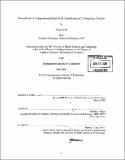ModuleFinder : a computational model for the identification of Cis regulatory modules
Author(s)
He, Fangxue
DownloadFull printable version (2.312Mb)
Alternative title
Module Finder : a computational model for the identification of Cis regulatory modules
Other Contributors
Harvard University--MIT Division of Health Sciences and Technology.
Advisor
Marth L. Bulyk.
Terms of use
Metadata
Show full item recordAbstract
Regulation of gene expression occurs largely through the binding of sequence- specific transcription factors (TFs) to genomic DNA binding sites (BSs). This thesis presents a rigorous scoring scheme, implemented as a C program termed "ModuleFinder", that evaluates the likelihood that a given genomic region is a cis regulatory module (CRM) for an input set of TFs according to its degree of: (1) homotypic site clustering; (2) heterotypic site clustering; and (3) evolutionary conservation across multiple genomes. Importantly, ModuleFinder obtains all parameters needed to appropriately weight the relative contributions of these sequence features directly from the input sequences and TFBS motifs, and does not need to first be trained. Using two previously described collections of experimentally verified CRMs in mammals as validation datasets, we show that ModuleFinder is able to identify CRMs with great sensitivity and specificity. We also evaluated ModuleFinder on a set of DNA binding site data for the human TFs Hepatocyte Nuclear Factor HNF1 [alpha], HNF4 [alpha] and HNF6 and compared its performance with logistic regression and neural network models.
Description
Thesis (S.M.)--Harvard-MIT Division of Health Sciences and Technology, 2005. Includes bibliographical references (leaves 55-57).
Date issued
2005Department
Harvard University--MIT Division of Health Sciences and TechnologyPublisher
Massachusetts Institute of Technology
Keywords
Harvard University--MIT Division of Health Sciences and Technology.